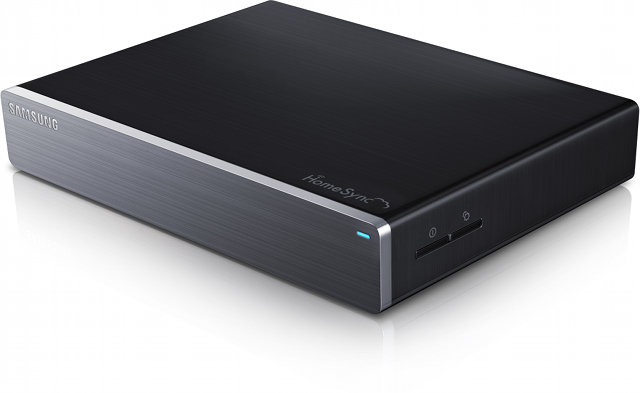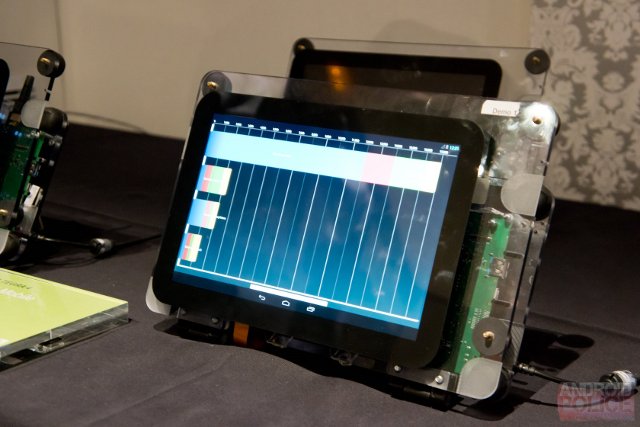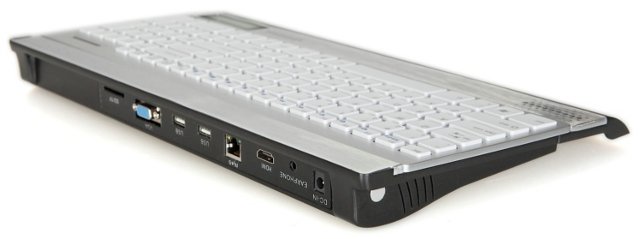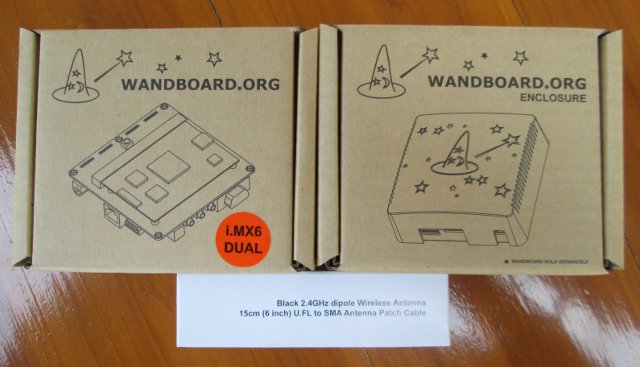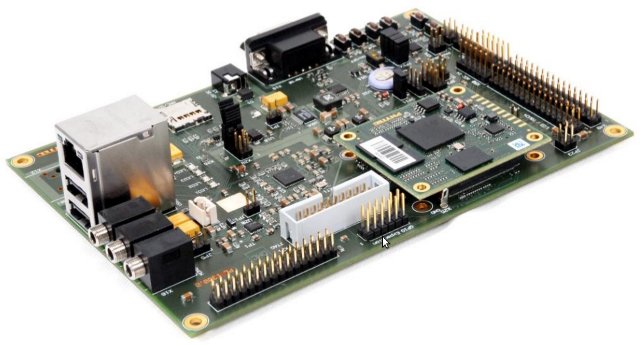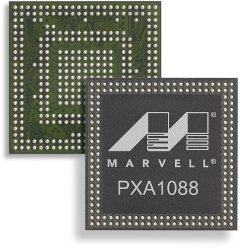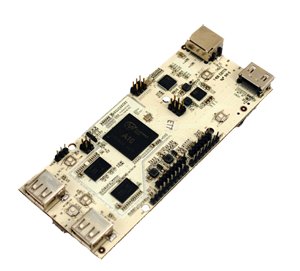Yesterday, Samsung announced the HomeSync, a media server featuring a dual core processor at 1.7 GHz, 1GB RAM, 8GB eMMC, and a 1TB hard drive. HomeSync is said to be running a modified version of Android Jelly Bean. Here are HomeSync specifications: Processor – Dual Core @ 1.7GHz (I’d guess it should be the Exynos 5250, but why all the mystery?) System Memory – 1GB DDR3 Storage – 8GB eMMC + 1TB HDD Connectivity LAN – Gigabit Ethernet WiFi – 802.11 b/g/n 2.4GHz & a/n 5GHz HT40 2×2 MIMO Channel Bonding Bluetooth – V4.0 USB – 2x USB 3.0 Host, 1x Micro USB (11pin) Video Output – HDMI out Audio – Optical Audio (Audio Amp. Connection) Video Codec – H.264, H.263, MPEG4, VC-1, Sorenson Spark, WMV7/8, MP43, VP8, DivX Audio Codec – MP3, AAC LC/AAC+/eAAC+, WMA 9std/10pro/Lossless, FLAC, Vorbis, AMR-NB/WB, Wav, Mid, AC-3 DRM – HDCP 1.3/2.1, Playready, Widevide, Trustzone […]
Nvidia Tegra 4 Benchmarks on Tablet Reference Design
Mobile World Congress 2013 has just started. Nvidia is showcasing both a smartphone reference platform based on Nvidia Tegra 4i (Phoenix reference phone) and an unnamed tablet reference design with Tegra 4 during the event, and several Android benchmarks have been run on the platform including Antutu and Quadrant. The results in the quad-core Cortex A15 Tegra 4 are really impressive with over 36,000 in AnTuTu and 16,000 in Quadrant, which are the best scores ever reported (by far) on those two benchmarks, as the top score in Antutu achieved with an overclocked Galaxy Note 2 is just over 27,000, a phone like the HTC One X scores around 5,600… Android Police also ran two other benchmarks that can help to access web browsing performance: Vellamo (HTML5) and SunSpider. The Tegra 4 completes SunSpider in 494ms (vs 1124ms with HTC One and 208ms in my desktop PC), and scores 3300 […]
ISEE Introduces IGEP COM CYGNUS & AQUILA Powered by TI Sitara AM335x Processor
ISEE will officially launch and showcase 2 new computers-on-module at Embedded World 2013 on February 26-28, in Nuremberg, Germany: IGEP COM CYGNUS and IGEP COM AQUILA. Both CoM shares the same characteristics except the former is powered by TI Sitara AM3352 (Cortex A8, no GPU) and the later by TI Sitara AM3354 (Cortex A8 + PowerVR GPU). This makes the CYGNUS suited for cost sensitive applications such as industrial control, home automation, and test and measurement devices, and the AQUILA for applications that requires more advanced graphics and multimedia capabilities such as gaming, auto infotainment and navigation devices. The key specifications of the 2 modules are as follows: Processor – Texas instruments Sitara AM3352 Cortex A8 @ 720 Mhz (CYGNUS) and AM3354 Cortex A8 @ 720 Mhz + PowerVR SGX GPU (AQUALIA) System memory – 256 MB DDR3 SDRAM, 303 MHz, 16-bit Storage – 128 MB SLC NAND FLASH + […]
CoolShip is a $89 Rockchip RK3066 Android Keyboard Desktop Computer
If you’re nostalgic and miss your Commodore C64, FocusWill Coolship could be right for you. It’s a keyboard desktop computer running Android 4.0 ICS (or a customized of Android version called CoolShip OS) powered by Rockchip RK3066 SoC with 1GB RAM, 4 to 8 NAND Flash, VGA and HDMI outputs and more. Here are the specifications of this device: SoC – Rockchip RK3066 Dual Cortex A9 @ 1.5Ghz + Mali-400MP4 GPU System Memory – 1GB DDR3 RAM Storage – 4 to 8 GB NAND Flash + SD Card slot Connectivity: 10/100Mbps Ethernet (via USB to Ethernet chip) 802.11b/g/n Keyboard – 104 Standard QWERTY keyboard with number keys + Touchpad Video Outputs – VGA + HDMI with dual display support. Video Codecs – MPEG-1/2/4, H.264, H.263, RMVB, WMV, VC-1, AVS, MVC, RV8/RV9/RV10, VP6/VP8 Audio I/O – Stereo Speakers (2×1Ω;0.7W), 1x MIC and 1x Earphone jack USB – 2x USB2.0 Power Supply […]
Wandboard Dual Unboxing and Quick Start Guide
I’ve just received Wanboard Dual development board together with an enclosure, and Wi-Fi antenna. This board is powered by Freescale i.MX6 Duallite Cortex A9 processor, and comes with 1GB RAM, HDMI output and Ethernet. There’s also a version based on Freescale i.MX6 Solo with 512 MB RAM. You can refer to my earlier post for more detailed specifications. I’ll start by showing some unboxing pictures of the board, and write a quick start guide (casing assembly, Ubuntu & Android boot, and development). I also planned to run some benchmarks and test videos, as according to a poll on Wandboard website many people want to use it as a media player, but I’ll do that a bit later since the current Android image is not up to the task yet. Wandboard Dual Unboxing The package I received contained 3 boxes: one for Wandboard Dual board, one for the enclosure, and one for […]
Phytec India Unveils “Open Board-AM335x” Development Kit
PHYTEC has launched the Open Board-AM335x development kit in order to support Linux and Android development on Texas Instruments AM335x Sitara ARM Processors in India. The Open Board-AM335x is comprised of a baseboard and phyCORE-AM335x SoM, and comes with 512 MB DDR3 SDRAM, 512 MB NAND Flash, and optionally, 8 MB SPI Flash. The baseboard is open source hardware as schematics and Gerber/BOM are freely available. Here are the key features of Phytec Open Board-AM335x: SoM – PhyCore-AM335x with ARM Cortex-A8 processors @ 720 MHz (AM3352, AM3354, AM3356, AM3357, AM3358 and AM3359) System Memory – 512 MB DDR3 RAM Storage – 512 MB NAND + SD Card slot + 8 MB SPI NOR Flash (Optional) + 32 KB EEPROM (Optional) Serial – 1x UART (RS232) + 4x UART (TTL) USB – 1x USB Host + 1x USB OTG Connectivity – 1x 10/100/1G Ethernet Audio – WM8974 Codec Display Interfaces – 24 bpp TTL […]
Marvell PXA1088 Quad Core Cortex A7 SoC
Marvell has just announced the MarvellPXA1088, a quad-core Cortex A7 application and communications mobile SoC that integrates Marvell’s WCDMA and TD-SCDMA modem technology to provide a low-cost 3G platform for both smartphones and tablets. Marvell’s mobile platform also includes Avastar 88W8777 WLAN + Bluetooth 4.0 + FM single-chip SoC, L2000 GNSS Hybrid Location Processor, and an integrated power management and audio codec IC. PXA1088 is said to be pin-to-pin compatible with the earlier PXA988/PXA986 solutions (dual core SoC) so that current mobile device designs can be upgraded with a quad-core SoC without additional development costs. Additional PXA1088 Features: Support for advanced WCDMA Release 7, TD-SCDMA HSPA+ Release 8, and class 12 EDGE 3G protocol stack certified on all major carrier networks and validated via IOT, GCF and field trail testing Support for popular full-feature operating systems (Including Android 4.2), and industry-standard development tools Multi-radio platform capabilities with WLAN/Bluetooth solutions Integrated […]
$59 pcDuino – AllWinner A10 Board with Arduino Compatible Headers
pcDuino is a new development board based on AllWinner A10 Cortex A8 SoC that comes with 1GB RAM and 2GB NAND Flash, HDMI output, as well as USB and Ethernet RJ45 ports, and is said to feature 2.54mm pin headers compatible with Arduino boards. Here are the pcDuino specifications: SoC – AllWinner A10 ARM Cortex A8 CPU @ 1GHz + Mali-400 GPU System Memory – 1GB DRAM Storage – 2GB Flash + SD card slot for up to 32GB Video Output – HDMI USB – 2x USB 2.0 Host Connectivity: Ethernet – 10/100 Mbps (RJ45) Wi-Fi – Via USB Wi-Fi dongle (not included with the board) Headers – 2.54mm pin headers: 1x UART, 6x ADCs, 2x PWMs up to 24MHz, 14x GPIOs, 1x I2C and 1x SPI. Power Supply – 5V/2A Dimensions – 125mm x 52mm The board comes preloaded with Ubuntu 12.10, but it also supports Android 4.0 ICS. […]


